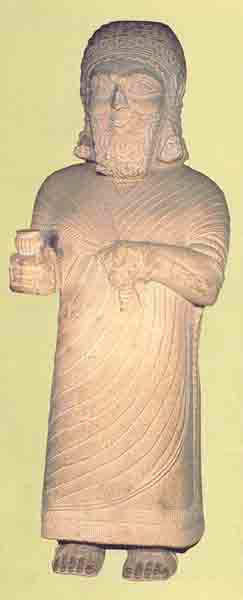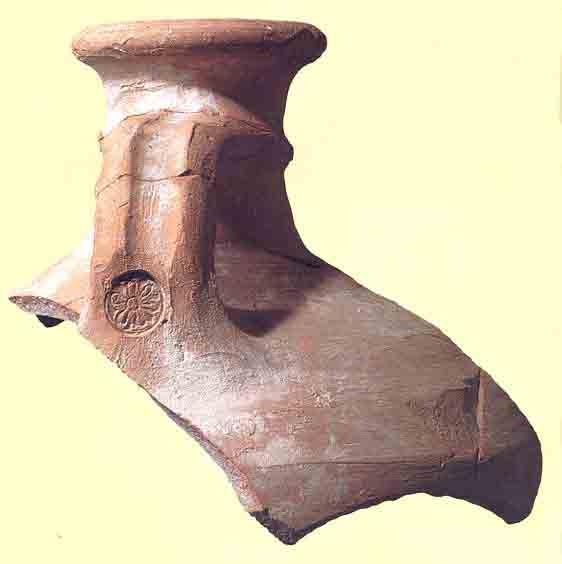
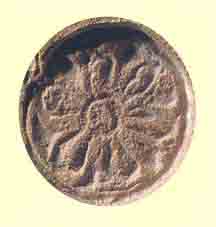
Although we didn’t recognize it at the time, during our recent excavation of the City of David we uncovered a wine decanter that may have graced the table of a high royal official of one of the last kings of Judah.
This is not simply idle speculation. We know that the vessel is a wine decanter because a similar vessel from Lachish bears an ink inscription identifying its contents as a particular type of wine.1 We know that it dates to the reign of one of the last kings of Judah because it was found in Stratum 10b at the City of David, which contains the remains of the city just before its destruction by Nebuchadnezzar. You will recall that the Babylonians, under Nebuchadnezzar, after twice laying siege to Jerusalem, finally captured it in 586 B.C.E. Nebuchadnezzar’s army then pillaged the city, destroying the Temple and sending the inhabitants off to exile in Babylonia.2
The only question is whether the decanter was used by a royal official. I believe I can show that this is a reasonable inference—not simply because it was found in the City of David, the oldest inhabited area of Jerusalem, but because it was found in a room attached to the house of a prominent family and because the decanter itself is stamped with what I believe I can demonstrate is a royal seal.
The decanter was uncovered in Area G of excavations directed by Yigal Shiloh of Hebrew University from 1978 to 1985. Tragically, Shiloh died at the age of 50, before beginning the final report.3 That task has been left in large part to the senior staff he assembled to assist him, which I joined in 1979.4
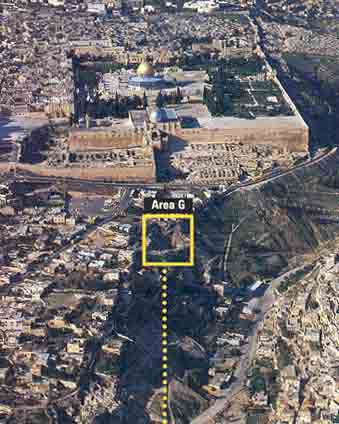
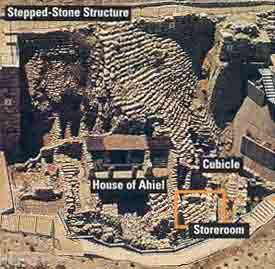
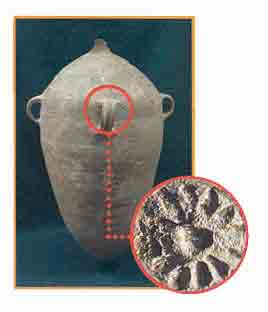
Area G could not have been far from the royal palace; in this same area we found a hoard of bullaea that may once have sealed official documents.5 A name on one of these bullae even belongs to someone mentioned in the Bible—Gemariah son of Shaphan, from whose office near the Temple Baruch read the words of Jeremiah to the people (Jeremiah 36:10).b
The wine decanter was found shattered on the plaster floor of a cubicle attached to the so-called House of Ahiel, which was built into the Stepped-Stone Structure on the City of David’s eastern slope. Clearly this house, which contained an inscription with the name “Ahiel,” belonged to a prominent family; it had a large central court, side rooms where animals may have been kept, second-story sleeping quarters supported by monolithic pillars, and a three-room addition that included a toilet, a storeroom filled with complete ceramic vessels and the small cubicle in which the rosette-stamped decanter was found.
Although broken just below the shoulder, our decanter is comparable in size and style to a complete decanter found in Stratum II at Lachish, which, like Stratum 10b in Area G at the City of David, was destroyed by the Babylonians in 586 B.C.E.6 Like the Lachish vessel, our decanter probably stood about a foot high and had a bag-shaped body resting on a small ring base. Stamped at the base of the handle of our decanter, however, is an eight-petalled rosette. And that is what I believe identifies this vessel as a royal object.
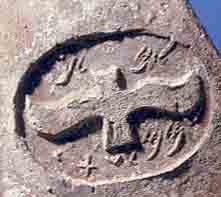
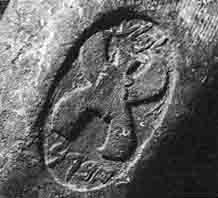
Abundant evidence from various Near Eastern kingdoms, as well as from Judah itself, shows that rosettes were associated with royalty and even divinity.
Although a corpus of nearly 250 rosette-stamped handles has been compiled, only two of these handles belong to large decanters,7 including the one we uncovered in the City of David. All the other rosette-stamped handles come from ovoid storage jars. One such jar, with prominent rosette impressions on two opposing handles, was recovered from the storeroom immediately east of the cubicle in which we found our decanter. In shape and form, the rosette-stamped storage jars are taller, narrower derivatives of storage jars stamped with the inscription “lmlk” (belonging to the king).c Each of these l’melech handles, as they are called, also bears a depiction of either a four-winged scarab or a two-winged disk. Because of the l’melech inscription, the stamps have been identified as royal, and the four-winged scarab and the two-winged disk have been interpreted as symbols of the Judahite monarchy.8
The similarity in form noted between the storage jars with l’melech impressions and those with rosettes suggests that the rosette motif, like the four-winged scarab and the two-winged disk, served as a symbol of Judah’s monarchy.
The similarity goes even further than this: Not only are the two kinds of ovoid storage jars similar in form, but chemical analysis has shown that they are made of the same kind of clay—meaning that both the l’melech– and the rosette-impressed jars may have come from the same production center.9 In addition, both types of impressions are found primarily within the territorial limits of ancient Judah.
The major difference between the two assemblages of stamped jar handles is their dates. The l’melech impressed-storage jars were produced in anticipation of Sennacherib’s campaign to Judah in the late eighth century B.C.E., whereas rosette-impressed jars were made in preparation for Nebuchadnezzar’s campaigns to Judah in the late seventh and early sixth centuries B.C.E. So the l’melech handles are dated to the reign of King Hezekiah (729–686 B.C.E.),10 and the rosette handles are dated to the reigns of the last Judahite kings: Jehoiakim (609–598 B.C.E.), Jehoiachin (597 B.C.E.) and Zedekiah (596–586 B.C.E.).11 The chronological difference between these two types of jar handles suggests that in the late seventh century B.C.E. the rosette motif replaced the four-winged scarab and the two-winged disk as a symbol of the Judahite monarchy.
Additional evidence that the rosette motif was a symbol of the Judahite monarchy comes from a dome-shaped limestone beq’a weightd with an eight-petalled rosette lightly incised on its flat base.12 The weight’s shape and size allow it to be dated to the late Iron Age II (eighth-seventh centuries B.C.E.).13 At least one and possibly two other Iron Age weights are incised with the l’melech inscription.14 Yigael Yadin compared the l’melech inscription on one of these weights to the l’melech inscriptions on the ovoid storage jar handles and concluded that in both cases the phrase l’melech indicated that the objects it appeared on were royal or official.15 In support of his theory, Yadin cited the appearance of winged scarabs without inscriptions on two metal weights from Nimrud that possibly originated as booty from Judah.16 By analogy, archaeologist Gabriel Barkay has compared the rosette on the beq’a weight to the rosettes on the storage jar handles and has concluded that the rosette motif replaced the phrase l’melech on weights and jar handles.17
A final piece of evidence from ancient Judah indicating the rosette’s royal significance comes from a beautiful brown jasper seal. Inscribed on the seal in Old Hebrew characters are the words “belonging to Ma’adanah the king’s daughter”18—identifying the seal as royal. The seal also bears a depiction of a 12-stringed lyre above the inscription. The lyre’s sound box is finely decorated around its lower edges; at its center is an elegant ten-petalled rosette.19 The seal’s owner, Ma’adanah, remains unidentified except as a king’s daughter, but this is not surprising, for Israelite women are rarely mentioned—in inscriptions or in the Bible—unless they played important roles in affairs of state.
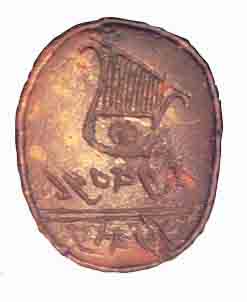
Outside of Judah the rosette motif was employed as a royal symbol of ruling houses in the ancient Near East at least as early as the Hittite empire in Anatolia (modern Turkey), during the 14th and 13th centuries B.C.E. From there it passed to the neo-Hittite kingdoms of north Syria, the Assyrian empire, the Transjordanian kingdom of Ammon and, eventually, to Judah.
Use of the rosette motif as a symbol of royalty appears to have originated with the Hittites, an Indo-European people who migrated to Anatolia around 2000 B.C.E. and subsequently became a world power. Winged rosettes appear on seal impressions bearing the names of Hittite kings and queens, including King Suppiluliuma I and Queen Tawananna (c. 1375–1335 B.C.E.), King Hattusili III and Queen Puduhepa (c. 1275–1250 B.C.E.), and King Tudhaliya IV (c. 1250-?).20
In north Syria, the rosette motif was used as a royal attribute at least by the ninth century B.C.E., when it appeared on a relief from the outer palace gate at Zincirli.21 This relief depicts King Kilamuwa, who is mentioned in the accompanying inscription; the king wears apointed crown and a rosette bracelet.
Use of the rosette as a royal attribute is also evidenced in the eighth century B.C.E. by a funeral stela from Zincirli and by a limestone statue from Malatya. The funeral stela portrays a woman identified by art historians as a queen or a princess. She sits on a throne decorated with three rows of rosettes and wears rosette-studded ornaments. Hovering above the entire scene is a winged rosette.22 The statue from Malatya portrays a local dignitary who can be identified as a king, partly because he wears an exquisitely chiseled diadem of eight-petalled rosettes.23
Further south, in Assyria, the rosette motif was also used as a royal symbol by the ninth century B.C.E. Reliefs recovered from the throne room of the Northwest Palace at Nimrud portray King Ashurnasirpal II (883–859 B.C.E.) wearing rosette bracelets while participating in activities that are standard expressions of kingship in Assyrian iconography: hunting, fighting and feasting.24
Almost every Assyrian king following Ashurnasirpal II is similarly portrayed wearing rosette-ornamented apparel: Shal-maneser III (858–824 B.C.E.), Shamshi-Adad V (823–811 B.C.E.), Tiglath-Pileser III (745–727 B.C.E.), Esarhaddon (680–669 B.C.E.) and Ashurbanipal (668–631 B.C.E.).25 The rosette’s prominent position in royal Assyrian art has led archaeologist David Ussishkin of Tel Aviv University to conclude that the Assyrian rosette was not merely a decorative element but a symbol of royal sovereignty.26
A dramatic example of the significance of the rosette appears in a relief depicting the Assyrian king Sennacherib’s conquest of Lachish shortly before 700 B.C.E.27 On the right side of the relief’s segment VI, Sennacherib is shown seated on a throne outside Lachish.28 At some point, vandals deliberately mutilated the king’s image on this segment by smashing his face and wrists.29 Why did they single out the wrists—a seemingly incidental detail in a monumental carving? Ussishkin concludes that Sennacherib’s wrists were smashed because he was portrayed wearing rosette bracelets as attributes of his royalty. If the bracelets were merely ornamental, there would have been no reason to destroy them.30 But in targeting Sennacherib’s wrists, and thus the royal rosettes, the vandals were attacking a symbol of power and kingship.
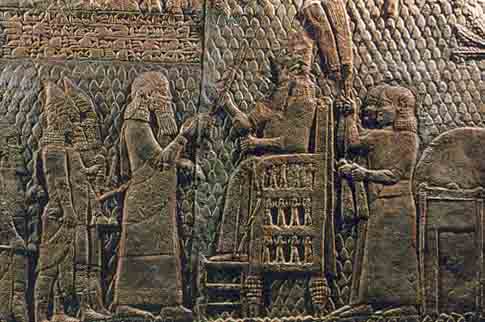
In Assyria the rosette motif was also used to identify royal officials and objects belonging to the king. In the palace reliefs of Ashurnasirpal II (883–859 B.C.E.), Sargon II (721–705 B.C.E.), Sennacherib (704–681 B.C.E.) and Ashurbanipal (668–631 B.C.E.),31 the trappings of the royal horses are decorated with rosettes. In the reliefs of Ashurbanipal, the king’s breastplate and quiver bear rosette designs, and the king’s guards carry rosette-studded shields.32 Royal officials wearing rosette-ornamented attire include the “keeper of the king’s bow,” portrayed in reliefs depicting Ashurnasirpal II (883–859 B.C.E.), officers of Tiglath-Pileser III (745–727 B.C.E.) and a high-ranking officer of Sennacherib’s army, who may himself have been a member of the royal family.33 But the Assyrians did not reserve the rosette motif for their own kings; they thought of it as a universal symbol of power and sovereignty. A relief from Sennacherib’s palace in Nineveh, for example, depicts Assyria’s invasion of Elam, in lower Mesopotamia. An Elamite prince, shown falling from his horse, wears a tunic decorated with rosettes.34
In the Transjordanian kingdom of Ammon, evidence of the use of the rosette motif as a symbol of royalty comes from a diadem of eight-petalled rosettes that graces the limestone bust of an “Ammonite king,” now in the Moshe Dayan Collection.35 We know the bust is Ammonite because of its stylistic similarities to Ammonite sculptures of the ninth and eighth centuries B.C.E.36 The figure is identified as a king not only by its headdress, reminiscent of the Egyptian Atef crown, but also by its diadem of eight-petalled rosettes, which closely resembles the diadem of eight-petalled rosettes on the neo-Hittite limestone statue from Malatya.
The ultimate source of the rosette motif’s popularity as a royal symbol appears to have been a belief, common in ancient Near Eastern cultures, in the close relationship between human and divine authority.37 In Hittite iconography, the rosette motif as a symbol of royalty appears to have derived from the notion that the great king was an incarnation of the sun god, whose symbol, the winged disk, later evolved into the winged rosette.38 For the Assyrians, kings ruled as divinely appointed executors of Ashur, the chief divinity of the Assyrian pantheon, whose attributes were the winged disk and the winged rosette.39 Thus, whether the local king was recognized as the incarnation of divine authority (as in the Hittite empire) or the divinely appointed executor of celestial rule (as in the Assyrian empire), the best representation of his royal power and authority was always the symbol of the chief god, with whom he was identified. Because in ancient Near Eastern cultures this symbol was often the rosette, the rosette motif became a popular manifestation of divine kingship throughout the region.
When Israelite kings adopted the rosette design, they were probably following the Assyrian model. In 721 B.C.E. the Assyrians destroyed the northern kingdom of Israel and dominated the southern kingdom of Judah as well, though they never captured Jerusalem. It was only after the Assyrians departed that Judah’s monarchs began to employ the rosette motif as a symbol of their own sovereignty. For Judahite kings, the rosette was the ideal symbol to represent their authority. First, because of the rosette’s importance as a royal symbol in Assyrian iconography, its significance was well known and needed no written explanation. Second, in iconographic terms, the rosette was an artistic variation of an earlier symbol of the Judean monarchy: the winged disk that accompanied the l’melech impressions of the previous century.
Thus the use of the rosette motif as a royal symbol in Judah exemplifies not only the Assyrian influence on Judahite culture but also the continuity of that culture from the eighth to the sixth centuries B.C.E.
MLA Citation
Footnotes
A bulla is a document sealer—made of wet clay, molten lead or some other quick-drying material—on which a seal impression is stamped.
See the following BAR articles: Tsvi Schneider, “Six Biblical Signatures: Seals and Seal Impressions of Six Biblical Personages Recovered,” BAR 17:04; Hershel Shanks, “Jeremiah’s Scribe and Confidant Speaks from a Hoard of Clay Bullae,” BAR 13:05; and Josette Elayi, “Name of Deuteronomy’s Author Found on Seal Ring,” BAR 13:05.
Each one of these l’melech inscriptions also includes the name of one of four towns in Judah: Hebron (22 miles southwest of Jerusalem), Socoh (in the Shephelah, 10 miles southwest of Hebron), Ziph (5 miles southeast of Hebron) and Mms
Endnotes
For a more detailed description of the Babylonian invasion of southern Palestine, see Lawrence E. Stager, “The Fury of Babylon: Ashkelon and the Archaeology of Destruction,” BAR 22:01.
For more information on Shiloh, see the two-part interview in BAR: Hershel Shanks, “Yigal Shiloh—Last Thoughts,” BAR 14:02 and
Author Jane M. Cahill co-supervised the excavations in Area G and is now responsible for publishing the results of those excavations.—Ed.
The variety of names appearing on these bullae suggests a public archive. See Yair Shoham, “A Group of Hebrew Bullae from Yigal Shiloh’s Excavations in the City of David,” in Ancient Jerusalem Revealed, ed. Hillel Geva (Jerusalem: Israel Exploration Society, 1994), p. 62. See also Hershel Shanks, “The City of David After Five Years of Digging,” BAR 11:06.
A second decanter bearing a rosette-impressed handle was recently identified during the restoration of pottery from excavations at the Jerusalem suburb of Motzah, directed by Alon DeGroot on behalf of the Israel Antiquities Authority. I thank Alon DeGroot for allowing me to mention the Motzah decanter.
See H. Darrell Lance, “Stamps, Royal Jar Handle,” in The Anchor Bible Dictionary 6 (New York: Doubleday, 1992), pp. 184–185.
H. Mommsen, I. Perlman and J. Yellin, “The Provenience of the lmlk Jars,” Israel Exploration Journal 34 (1984), p. 112.
Ussishkin, “The Destruction of Lachish by Sennacherib and the Dating of the Royal Judean Storage Jars,” Tel Aviv 4 (1977), pp. 28–57.
Jane M. Cahill, “Rosette Stamp Seal Impressions from Ancient Judah,” Israel Exploration Journal 45 (1995), pp. 247–250.
Gabriel Barkay, “A Group of Iron Age Scale Weights,” Israel Exploration Journal 28 (1978), p. 210, fig. 1:3, pp. 212–213, and pls. 33:E-G.
R.A.S. Macalister, The Excavations of Gezer II (London: Murray, 1912), p. 285, fig. 433; A. Ben-David, “A Rare Inscribed nzf Weight,” Israel Exploration Journal 23 (1973), pp. 176–177.
Yigael Yadin, “Ancient Judean Weights and the Date of the Samaria Ostraca,” Scripta Hierosolymitana 8 (1961), pp. 9–25, esp. p. 14.
James B. Pritchard, The Ancient Near East in Pictures Relating to the Old Testament (Princeton, NJ: Princeton University, 1954), p. 36, fig. 121.
Nahman Avigad, “The King’s Daughter and the Lyre,” Israel Exploration Journal 28 (1978), pp. 146–151.
Although a recent publication has noted the many unique attributes of this seal, its authenticity has not been seriously challenged. See Benjamin Sass, “The Pre-exilic Hebrew Seals: Iconism and Uniconism,” in Studies in the Iconography of Northwest Semitic Inscribed Seals, ed. Sass and Christoph Uehlinger (Göttingen: Vandenhoech and Ruprecht, 1993), p. 242.
Richard D. Barnett, Assyrian Palace Reliefs and Their Influence on the Sculptures of Babylonia and Persia (London: Batchworth Press Ltd., 1960), pls. 25–29; Pierre Amiet, Art of the Ancient Near East, trans. John Shepley and Claude Choquet (New York: Abrams, 1980), p. 283, pls. 119, 121, p. 406, pl. 603.
For Shalmaneser III, see Amiet, Art, p. 293, pl. 122. For Shamshi-Adad V, Tiglath-Pileser III and Esarhaddon, see Pritchard, Ancient Near East, pp. 153–154, 300, pls. 442, 445, 447. For Ashurbanipal, see Barnett, Assyrian Palace Reliefs, pp. 29–30, pls. 61, 63, 65, 83–84, 105; Amiet, Art, pp. 103, 413–415, 418, pls. 126, 129, 618, 623, 634.
Ussishkin, The Conquest of Lachish by Sennacherib (Tel Aviv: Tel Aviv Univ., Institute of Archaeology, 1982), p. 115.
For Ashurnasirpal II, see Amiet, Art, p. 283, pl. 119, p. 406, pl. 603; and Barnett, Assyrian Palace Reliefs, pp. 27–28, pl. 26–27. For Sargon II, see Barnett, Assyrian Palace Reliefs, p. 28, pl. 43. For Sennacherib, see Ussishkin, Conquest of Lachish, pp. 88–89, fig. 71, pp. 90–91, fig. 72. For Ashurbanipal, see Barnett, Assyrian Palace Reliefs, p. 29, pl. 64, p. 30, pl. 99.
For the breastplate, quiver and shield; see Barnett, Assyrian Palace Reliefs, p. 29, pls. 84, 82, 76.
For Ashurnasirpal II’s bow holder, see Barnett, Assyrian Palace Reliefs, p. 28, pl. 31. For Tiglath-Pileser III’s officers, see Barnett and Margarete Falkner, The Sculptures of Assur-nasir-apli II (883–859 B.C.), Tiglath-Pileser III (745–727 B.C.), Esarhaddon (681–669 B.C.) from the Central and South-West Palaces at Nimrud (London: British Museum, 1962), p. 55, pl. 6, p. 72, pl. 23. For Sennacherib’s high-ranking officer, see Ussishkin, Conquest of Lachish, pp. 88–89, 115, fig. 71.
Tallay Ornan, “The Dayan Collection,” Israel Museum Journal 2 (1983), pp. 14–16, 18 n. 63. Ornan notes that a similar rosette diadem is seen on a female bust now in the collection of Mr. and Mrs. A. Spaer of Jerusalem. Because the Spaer bust appears to have been purchased from the same source as the bust in the Dayan Collection, the two busts may originally have formed a pair and should perhaps be identified as an Ammonite king and queen.
Moawiyah M. Ibrahim, “Two Ammonite Statuettes from Khirbet el-Hajjar,” Annual of the Department of Antiquities of Jordan 16 (1971), pp. 91–97.
Henri Frankfort, Kingship and the Gods (Chicago: Univ. of Chicago Press, 1948), pp. 224–226, 237.
William F. Albright, “Editorial Note,” Bulletin of the American Schools of Oriental Research 80 (1940), p. 21 n. 51.





